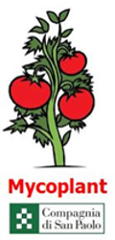Mycoplant - CONCLUDED
Aree / Gruppi di ricerca
Partecipanti al progetto
- Prof.ssa BONFANTE Paola (Coordinatore/trice)
- Binello Arianna (Ricercatore/trice)
- Cravotto Giancarlo (Docente)
- Mantegna Stefano (Tecnico/a)
Descrizione del progetto

Sponsors:
Members:
Mariangela Girlanda (Dipartimento di Scienze della Vita e Biologia dei Sistemi)
Silvia Perotto (Dipartimento di Scienze della Vita e Biologia dei Sistemi)
Davide Carmelo Spadaro (Dipartimento di Scienze Agrarie, Forestali e Alimentari)
Giovanna Varese (Dipartimento di Scienze della Vita e Biologia dei Sistemi)
Members of other units:
Valeria Bianciotto (CNR), Stefano Ghignone (CNR), Erica Lumini (CNR), Roland Marmeisse (University Calude Bernard Lyon 1), Laura Miozzi (CNR)
Partners:
University of Turin (Life Sciences and Systems Biology, DSTF, DISAFA)
University Calude Bernard Lyon 1
CNR
Sponsors:
Compagnia di San Paolo
Description
An increasing body of evidence illustrates how the health of multicellular organisms such as animals and plants relies on their tight association with specialized microbial communities (microbiomes). Due to their interdependency, plants and their associated microbiomes can be viewed as “super-organisms” which mutually enhance their metabolisms. In the classical reductionist approach, interactions with soil microbes has been studied mostly in a one-to-one combination. For example, it has been shown that the association between soil arbuscular mycorrhizal fungi and plant roots improve plant mineral nutrition, fortifies the plant against biotic and abiotic stresses, and creates positive systemic effects.
In the last years, the study of plant-microbes interactions has taken advantage of the -omic approach. The innovative next generation sequencing technologies (NGS) have revolutionised our understanding of the ecology of niches like waters and soils, and of their functioning. While barcoding allows researchers to better evaluate biodiversity, large scale analyses such as mRNA-Seq can reveal the full transcriptomic
profile of one or more organisms. The main goal of this proposal is to combine NGS, proteomics, metabolomics and plant genetics to infer the principles underlying plant–microbes interactions at a community level. We will focus on the model plant Solanum lycopersicum (tomato) and its root-associated fungal biomes. In addition to its known genome and the large number of genetics tools currently available, tomato is a priority for the Italian economy. This sector needs novel discoveries to innovate and improve crop quality and yield. The outcome of the project is expected to provide new knowledge on a scientific hot
spot (how microbiomes impact on plants and how plants actively shape their own microbiomes) but also on the establishment of best practices for the use of microbiota to increase plant health in agricultural settings.
The scientific objectives of the project are:
A) To assess to what extent plant genotypes and soil types modulate the plant-associated fungal microbiome in terms of diversity and metabolic activities.
- A.1) To investigate how tomato genotypes, either susceptible or resistant to the pathogen FOL, modulate the root-associated microbiome.
- A.2) To investigate the composition of tomato root-associated fungal biomes originating from diseasesuppressive and non-suppressive soils.
B) To investigate metabolic activities and signaling in the rhizosphere.
- B.1) To investigate gene and protein expression in the rhizosphere.
- B.2) To identify potential chemical signals capable of shaping the microbiome.
C) To assess how diverse fungal microbiomes affect tomato growth and health.
- C.1) To investigate modification of functional and agronomic traits in tomato.
- C.2) To set up and test reconstructed microbiomes in microcosm.
D) To use network analysis as a bioinformatic tool in data management
- D.1) To integrate plant transcriptomic and proteomic information in biological networks.
- D.2) To identify the artificial microcosm with the best suppressive response.
Milestones:
- 1 To highlight differences, in terms of operational taxonomic units (O.T.Us), in the root-associated fungi of tomato genotypes either susceptible or resistant to the pathogen F. oxysporum f. sp. lycopersici.
- 2 To highlight the different composition of root-associated fungi (in terms of O.T.Us) from suppressive and non-suppressive soils.
- 3 To isolate fungi from the four investigated microbiomes.
- 4 To functionally characterize isolated fungi and maintain them in a biological resource centre for future exploitation in the creation of tailored inocula.
- 5 To evaluate functional proteins/enzymes expressed in the rhizophere under different conditions.
- 6 To chemically identify the main plant and fungal metabolites involved in the microbiome shaping and in the suppression of soil-borne pathogens.
- 7 To describe the global transcriptome profile of tomato plants in the presence of natural suppressive and non suppressive soils containing different microbiomes
- 8 To identify the plant molecular markers specifically related to the disease-suppressive soils, that may have an effect on the plant functionality.
- 9 To set up an artificial fungal biome
- 10 To identify the fungal components which confer disease-suppressiveness.
- MD.1.To describe the network of interactions between tomato plants and soil fungi
- 11 To identify to rhizosphere conditions which better mimic the disease suppressive-soil
- 12 To select fungal strains for developing specific, tailored inocula to improve plant functionality
Keywords:
Plant health, Microbiome, Biosystems, Omics approaches, NSG, Fungal biome, Mycorrhizal fungi, Saprobes, Biocontrol fungi, Secondary metabolites, Ecological services




